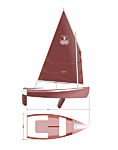Sailing and rowing skiff "Kumbli"
The term “skiff” can be used to describe many different types of small boats. Skiff boats are some of the most popular boats around, and once you get to know how pleasant life can be in a skiff, it’s no wonder why.
They are simple, inexpensive, and yet very useful. With great initial stability, they are seaworthy, and easily driven by sail and oar or low power outboard. It will handle calm or choppy water and will be as easy and fun a building project as you could ever hope for.
Our skiff’s 4 metres of length means it’s easy to handle on the water, easy to tow with a light-duty tow vehicle, and—critical for many people—it’s also easy to afford in the first place.
CNC cut kit allows easy construction for first-timers, including slot-together frames, pre-drilled holes for stitch-and-glue, puzzle joints, and high precision in the fitting of parts.
Okume marine-grade plywood of 6mm thickness is used for the hull construction, and 10mm for the transom, bulkheads and centerboard case. We recommend sheathing the sole and the exterior of the hull with a glass fiber cloth and epoxy laminate for higher rigidity and wear resistance.
The lug sail is highly efficient, quick to rig and unrig. The other advantage of the lug rig is that it reefs very simply - the sail area is 7.9 sq m so with the hull's light weight it has quite a big power to weight ratio for good fine weather performance. When the weather blows up then it can be reefed for good control. This is also why this boat is relatively cheap to get on the water - having a single big sail is a lot cheaper than having several smaller ones.
The transom is designed for a short-shaft (15" or 38 cm) engine. Because of its hull shape, the Kumbli Islet Skiff can't use more than about 3 or 4 hp effectively. Even 2 hp will push her along at good speed. Higher horsepowers are not very useful because the hull is not the right shape to go faster - it will stand up on its stern and start pounding in waves.
The boat balances quite OK if there is someone else in the boat to sit in the front with the driver on the rear seat. With one person the boat will balance better if a tiller extension for the outboard is used so you can sit on the middle seat.
Main dimensions:
- length 4m
- width: 1,64m
- waterine length: 3,9m
- draft / CB down: 0,13m / 0,79m
- freeboard: 0,55m
- height from waterline to top of sail: 5,5m
- sail area: 7,9sq.













